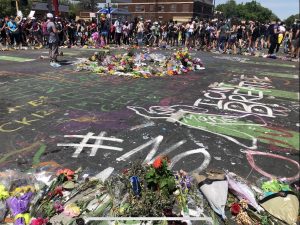Kristina Fruge, Managing Director of CCV, writes about the importance of confession and humility when doing the work of being a public church.
A neighbor-oriented call
The work of the Riverside Innovation Hub has been guided by an orientation towards the neighbor. This is both an invitation to pay attention in the neighborhood and a plea to be open to disruption we might encounter outside the comforts of our familiar surroundings.
This neighbor-oriented way of living, when embodied by a Christian congregation, becomes a public church. As churches and as individuals, this call to be public, to encounter our neighbor, leads us into the public square. This is not a neutral place to be. It is filled with other humans, each with their own story, their own struggle, their own world view. It is shaped by systems and structures, which more often than not, have shaped conditions in the world that stray far from God’s intentions for creation. There is beauty and destruction. There are signs of life and threats to life. The public square holds potential and heartache.
 Our neighborhoods have been shaped by violent and dishonest histories – ones that have regularly privileged some groups of people at the expense of others. Entering the public square challenges us to make a choice.
Our neighborhoods have been shaped by violent and dishonest histories – ones that have regularly privileged some groups of people at the expense of others. Entering the public square challenges us to make a choice.
Will we show up and participate in the dominant and dominating histories still at play in our neighborhoods? Or will we show up to participate in an alternative way, a way that seeds peace, truth and healing? A way that requires confession and humility?
These questions take on a greater responsibility if you are someone who lives with any kind of privileged identity around race, gender, able-bodiedness, sexual orientation, or socio-economic status. These hierarchies, shaping our communities since long ago, continue to cause harm today. If we enter the public square ignorant of these harmful realities, we risk showing up in ways that perpetuate the lies and violence of our country’s past and present.
Continue reading “Humility & Confession in the Public Square”

